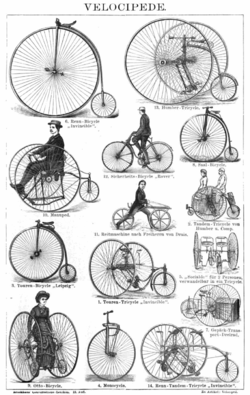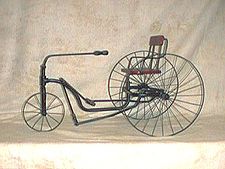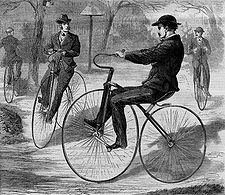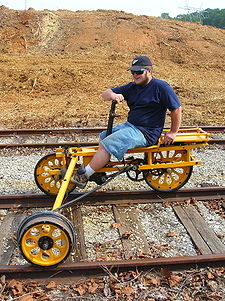
Velocipede
Encyclopedia



Umbrella term
An umbrella term is a word that provides a superset or grouping of concepts that all fall under a single common category. Umbrella term is also called a hypernym. For example, cryptology is an umbrella term that encompasses cryptography and cryptanalysis, among other fields...
for any human-powered land vehicle with one or more wheels. The most common type of velocipede today is the bicycle
Bicycle
A bicycle, also known as a bike, pushbike or cycle, is a human-powered, pedal-driven, single-track vehicle, having two wheels attached to a frame, one behind the other. A person who rides a bicycle is called a cyclist, or bicyclist....
.
The term was coined by Frenchman Nicéphore Niépce
Nicéphore Niépce
Nicéphore Niépce March 7, 1765 – July 5, 1833) was a French inventor, most noted as one of the inventors of photography and a pioneer in the field.He is most noted for producing the world's first known photograph in 1825...
in 1818 to describe his version of the Laufmaschine, which was invented by the German Karl Drais
Karl Drais
Karl Drais was a German inventor and invented the Laufmaschine , also later called the velocipede, draisine or "draisienne" , also nicknamed the dandy horse. This incorporated the two-wheeler principle that is basic to the bicycle and motorcycle and was the beginning of mechanized personal...
in 1817. The term "velocipede" is today, however, mainly used as a collective term for the different forerunners of the monowheel
Monowheel
A monowheel is a one-wheeled single-track vehicle similar to a unicycle. However, instead of sitting above the wheel, the rider sits either within it or next to it. The wheel is a ring, usually driven by smaller wheels pressing against its inner rim...
, the bicycle
Bicycle
A bicycle, also known as a bike, pushbike or cycle, is a human-powered, pedal-driven, single-track vehicle, having two wheels attached to a frame, one behind the other. A person who rides a bicycle is called a cyclist, or bicyclist....
, the dicycle
Dicycle (vehicle)
A dicycle is a vehicle with two wheels side by side, unlike single-track vehicles such as motorcycles and bicycles, which have one wheel followed by another....
, the tricycle
Tricycle
A tricycle is a three-wheeled vehicle. While tricycles are often associated with the small three-wheeled vehicles used by pre-school-age children, they are also used by adults for a variety of purposes. In the United States and Canada, adult-sized tricycles are used primarily by older persons for...
and the quadracycle
Quadracycle
A quadracycle is a four-wheeled human-powered vehicle. It is also referred to as a quadricycle, quadcycle pedal car or four-wheeled bicycle, amongst other terms....
developed between 1817 and 1880.
History
Among the early velocipedes there were designs with one, two, three and four wheels. Some two-wheeled designs had pedals mounted on the front wheel, while three- and four-wheeled designs sometimes used treadles and leverLever
In physics, a lever is a rigid object that is used with an appropriate fulcrum or pivot point to either multiply the mechanical force that can be applied to another object or resistance force , or multiply the distance and speed at which the opposite end of the rigid object travels.This leverage...
s to drive the rear wheels.
The earliest usable and much copied velocipede was created by the German Karl Drais
Karl Drais
Karl Drais was a German inventor and invented the Laufmaschine , also later called the velocipede, draisine or "draisienne" , also nicknamed the dandy horse. This incorporated the two-wheeler principle that is basic to the bicycle and motorcycle and was the beginning of mechanized personal...
and called a Laufmaschine (German for "running machine"), which he first rode on June 12, 1817. He obtained a patent in January 1818. This was the world's first balance bicycle
Balance bicycle
A balance bicycle, or run bike is a training bicycle that helps children learn balance and steering. It has no pedals, no crankset and chain, and no training wheels.-Designs:Balance bikes have been made out of both metal and wood...
and quickly became popular in both the United Kingdom and France, where it was sometimes called a draisine
Draisine
A draisine primarily refers to a light auxiliary rail vehicle, driven by service personnel, equipped to transport crew and material necessary for the maintenance of railway infrastructure....
(German and English), draisienne (French), a vélocipède (French), a swiftwalker, a dandy horse
Dandy horse
The dandy-horse, also known as hobby-horse, is a human-powered vehicle that, being the first means of transport to make use of the two-wheeler principle, is regarded as the forerunner of the bicycle. The dandy horse was invented by Baron Karl Drais in Mannheim, Germany, and patented in January 1818...
(as it was very popular among dandies
Dandy
A dandy is a man who places particular importance upon physical appearance, refined language, and leisurely hobbies, pursued with the appearance of nonchalance in a cult of Self...
) or a Hobby horse
Hobby horse
The term hobby horse is used, principally by folklorists, to refer to the costumed characters that feature in some traditional seasonal customs, processions and similar observances around the world. They are particularly associated with May Day celebrations, Mummers Plays and the Morris dance in...
. It was made entirely of wood and had no practical use except on a well-maintained pathway in a park or garden.
The term "velocipede" was coined in 1818 by Nicéphore Niépce
Nicéphore Niépce
Nicéphore Niépce March 7, 1765 – July 5, 1833) was a French inventor, most noted as one of the inventors of photography and a pioneer in the field.He is most noted for producing the world's first known photograph in 1825...
to describe his own "improved" version of the Drais Laufmaschine, that included an adjustable saddle
Bicycle saddle
A bicycle saddle, often called a seat, is one of three contact points on an upright bicycle, the others being the pedals and the handlebars.The bicycle saddle has been known as such since the bicycle evolved from the draisine, a forerunner of the bicycle...
. It was, however, almost 40 years until "velocipede" came into common usage as a generic term, with the launch of the first pedal
Bicycle pedal
A bicycle pedal is the part of a bicycle that the rider pushes with their foot to propel the bicycle. It provides the connection between the cyclist's foot or shoe and the crank allowing the leg to turn the bottom bracket spindle and propel the bicycle's wheels...
-equipped bicycle
Bicycle
A bicycle, also known as a bike, pushbike or cycle, is a human-powered, pedal-driven, single-track vehicle, having two wheels attached to a frame, one behind the other. A person who rides a bicycle is called a cyclist, or bicyclist....
, developed by Pierre Michaux
Pierre Michaux
Pierre Michaux was a blacksmith who furnished parts for the carriage trade in Paris during the 1850s and 1860s. He started building bicycles with pedals in the early 1860s. He, or his son Ernest, may have been the inventor of this machine, by adapting cranks and pedals on the front wheel of a...
, Pierre Lallement
Pierre Lallement
Pierre Lallement is considered by some to be the inventor of the bicycle.-Early years:Lallement was born on October 25, 1843 in Pont-à-Mousson near Nancy, France....
and the Olivier brothers
Olivier brothers
The Olivier brothers, Aimé, René, and Marius, were the first people responsible for recognizing the commercial potential of a new invention : the bicycle....
in the 1860s. The Michaux
Pierre Michaux
Pierre Michaux was a blacksmith who furnished parts for the carriage trade in Paris during the 1850s and 1860s. He started building bicycles with pedals in the early 1860s. He, or his son Ernest, may have been the inventor of this machine, by adapting cranks and pedals on the front wheel of a...
company was the first to mass-produce the velocipede, from 1867 to 1870. That French design was sometimes called the boneshaker, since it was also made entirely of wood, then later with metal tires. That in combination with the cobblestone roads of the day made for an extremely uncomfortable ride. These velocipedes also became a fad, and indoor riding academies, similar to roller rinks, could be found in large cities.
During the 1870s advances in metallurgy led to the development of the first all-metal velocipedes. The pedals were still attached directly to the front wheel, which became larger and larger as makers realised that the larger the wheel, the farther you could travel with one rotation of the pedals. Solid rubber tires and the long spokes of the large front wheel provided a much smoother ride than its predecessor. This type of velocipede was the first one to be called a bicycle ("two wheel"), and its shape led to the nickname penny-farthing
Penny-farthing
Penny-farthing, high wheel, high wheeler, and ordinary are all terms used to describe a type of bicycle with a large front wheel and a much smaller rear wheel that was popular after the boneshaker, until the development of the safety bicycle, in the 1880s...
in the United Kingdom. They enjoyed a great popularity among young men in the 1880s who could afford them.
While young men were risking their necks on the high wheels, ladies and dignified gentlemen such as doctors and clergymen of the 1880s favoured the less risky tricycle. Many innovations for tricycles eventually found their way into the automobile
Automobile
An automobile, autocar, motor car or car is a wheeled motor vehicle used for transporting passengers, which also carries its own engine or motor...
, such as rack and pinion steering, the differential, and band brake
Band brake
A band brake is a primary or secondary brake, consisting of a band of friction material that tightens concentrically around a cylindrical piece of equipment to either prevent it from rotating , or to slow it . This application is common on winch drums and chain saws and is also used for some...
s, the forerunners to drum brake
Drum brake
A drum brake is a brake in which the friction is caused by a set of shoes or pads that press against a rotating drum-shaped part called a brake drum....
s.
Boneshaker
Boneshaker (or bone-shaker) is a name used from about 1869 up to the present time to refer to the first type of true bicycleBicycle
A bicycle, also known as a bike, pushbike or cycle, is a human-powered, pedal-driven, single-track vehicle, having two wheels attached to a frame, one behind the other. A person who rides a bicycle is called a cyclist, or bicyclist....
with pedals, which was called velocipede by its manufacturers. "Boneshaker" refers to the extremely uncomfortable ride, which was caused by the stiff wrought-iron frame
Bicycle frame
A bicycle frame is the main component of a bicycle, on to which wheels and other components are fitted. The modern and most common frame design for an upright bicycle is based on the safety bicycle, and consists of two triangles, a main triangle and a paired rear triangle...
and wooden wheels
Bicycle wheel
A bicycle wheel is a wheel, most commonly a wire wheel, designed for bicycle. A pair is often called a wheelset, especially in the context of ready built "off the shelf" performance-oriented wheels....
surrounded by tires made of iron.
History
This type of bicycle was invented in the 1860s in France, and first manufactured by the Michaux company from 1867 to 1869 – the time of the first bicycle craze, and copied by many others during that time. It fell out of favor after the summer of 1869, and was replaced in 1870 with the type of bicycle called "ordinary", "high-wheel", or "penny-farthingPenny-farthing
Penny-farthing, high wheel, high wheeler, and ordinary are all terms used to describe a type of bicycle with a large front wheel and a much smaller rear wheel that was popular after the boneshaker, until the development of the safety bicycle, in the 1880s...
".
Few original boneshakers exist today, most having been melted for scrap metal
Scrap Metal
Scrap Metal were a band from Broome, Western Australia who played rock music with elements of country and reggae. The members had Aboriginal, Irish, Filipino, French, Chinese, Scottish, Indonesian and Japanese heritage. The band toured nationally as part of the Bran Nue Dae musical and with...
during World War I. Those that do surface from time to time command high prices, typically up to about $5,000 US.
Design
The construction of the boneshaker was similar to the dandy horseDandy horse
The dandy-horse, also known as hobby-horse, is a human-powered vehicle that, being the first means of transport to make use of the two-wheeler principle, is regarded as the forerunner of the bicycle. The dandy horse was invented by Baron Karl Drais in Mannheim, Germany, and patented in January 1818...
: wooden wheels with iron
Iron
Iron is a chemical element with the symbol Fe and atomic number 26. It is a metal in the first transition series. It is the most common element forming the planet Earth as a whole, forming much of Earth's outer and inner core. It is the fourth most common element in the Earth's crust...
tires and a framework of wrought iron
Wrought iron
thumb|The [[Eiffel tower]] is constructed from [[puddle iron]], a form of wrought ironWrought iron is an iron alloy with a very low carbon...
. As the name implies it was extremely uncomfortable, but the discomfort was somewhat ameliorated by a long flat spring
Spring (device)
A spring is an elastic object used to store mechanical energy. Springs are usually made out of spring steel. Small springs can be wound from pre-hardened stock, while larger ones are made from annealed steel and hardened after fabrication...
that supported the saddle
Saddle
A saddle is a supportive structure for a rider or other load, fastened to an animal's back by a girth. The most common type is the equestrian saddle designed for a horse, but specialized saddles have been created for camels and other creatures...
and absorbed many of the shocks from rough road surfaces. The boneshaker also had a brake
Bicycle brake systems
A bicycle brake is used to slow down or stop a bicycle. There have been various types of brake used throughout history, and several are still in use today...
- a metal lever that pressed a wooden pad against the rear wheel. The front wheel axle
Axle
An axle is a central shaft for a rotating wheel or gear. On wheeled vehicles, the axle may be fixed to the wheels, rotating with them, or fixed to its surroundings, with the wheels rotating around the axle. In the former case, bearings or bushings are provided at the mounting points where the axle...
ran in lubricated bronze bearings, and some had small lubrication
Lubrication
Lubrication is the process, or technique employed to reduce wear of one or both surfaces in close proximity, and moving relative to each another, by interposing a substance called lubricant between the surfaces to carry or to help carry the load between the opposing surfaces. The interposed...
tanks that would wick oil from soaked lamb's wool into the bearings to help them run smoothly. Like the High Wheel
Penny-farthing
Penny-farthing, high wheel, high wheeler, and ordinary are all terms used to describe a type of bicycle with a large front wheel and a much smaller rear wheel that was popular after the boneshaker, until the development of the safety bicycle, in the 1880s...
bicycles that became popular later in the 19th century, boneshakers were front-wheel drive, but in comparison they had smaller wheels
Bicycle wheel
A bicycle wheel is a wheel, most commonly a wire wheel, designed for bicycle. A pair is often called a wheelset, especially in the context of ready built "off the shelf" performance-oriented wheels....
(only about 1m), and were heavy, with a lightweight model weighing 30 pounds or more.
In railroad use

North America
North America is a continent wholly within the Northern Hemisphere and almost wholly within the Western Hemisphere. It is also considered a northern subcontinent of the Americas...
often made use of a three-wheeled handcar
Handcar
A handcar is a railroad car powered by its passengers, or by people pushing the car from behind. It is mostly used as a maintenance of way or mining car, but it was also used for passenger service in some cases...
designed to be operated by a single person. This came to be known as a 'velocipede'.
International association
The International Veteran Cycling AssociationInternational Veteran Cycling Association
The International Veteran Cycle Association promotes interest in the history of cycling. Its principal activity is the organisation of annual rallies, a different country hosting a programme for members each year.-History and objectives:...
(IVCA) promotes interest in the history of cycling
Cycling
Cycling, also called bicycling or biking, is the use of bicycles for transport, recreation, or for sport. Persons engaged in cycling are cyclists or bicyclists...
. Its principal activity is the organization of annual rallies
Rally
Rally refers to a gathering, as in:* Political rally, a demonstration, march, or parade* Pep rally, an event held at a United States school or college sporting eventRally as a sports term can also refer to:* Rallying, a category of motorsport...
with a different country hosting a program for members each year.
External links
- The Velocipede Museum, Old New Castle, Delaware USA
- 19th century picture of a Velocipede supposedly outrunning a horse
- Musée McCord Museum Gallery "A Race on the Ice - Bicycles v. Skates"
The Boneshaker. Retrieved 28 June 2010.

